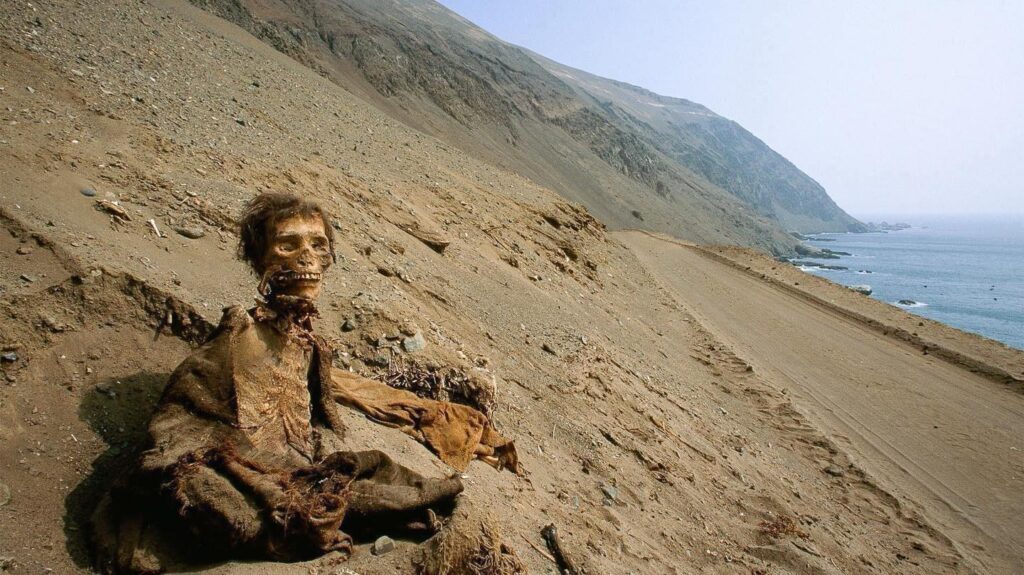1. The Atacama Desert: A Natural Time Capsule
Chile’s Atacama Desert is one of the driest places on Earth, with some regions receiving virtually no rainfall for decades. These extreme arid conditions create an unparalleled environment for preserving organic material. In this climate, a corpse buried for centuries can remain remarkably intact, retaining its skin, hair, and even clothing. Such natural preservation occurs because the lack of moisture halts the decomposition process, turning the desert into a natural time capsule that offers a window into the distant past.
2. Discovery of Naturally Preserved Bodies
When researchers or archaeologists uncover naturally dehydrated bodies in the Atacama Desert, they are often struck by their incredible state of preservation. These bodies, with intact features and fabrics, provide not only a haunting glimpse of the individuals who lived long ago but also invaluable data about their clothing, diets, and rituals. These discoveries also raise an intriguing question: did the natural mummification process inspire early cultures to develop artificial techniques to preserve their dead?
3. The Chinchorro People: Pioneers of Mummification
Long before the Egyptian pharaohs were wrapped and entombed, the Chinchorro people of northern Chile and southern Peru were practicing mummification. Dating back as early as 5050 BCE, the Chinchorro mummies are among the oldest examples of deliberate human preservation. The Chinchorro’s mummification techniques evolved over time, beginning with simple methods and advancing to highly sophisticated procedures.
- Egalitarian Preservation: Unlike many ancient cultures, the Chinchorro mummified individuals regardless of age, gender, or social status. Infants, children, adults, and even fetuses were preserved with equal care, reflecting a deep communal respect for the dead.
- Innovative Techniques: Chinchorro mummification involved removing internal organs, replacing them with natural fibers or clay, and reconstructing the body with a mixture of materials, often coating it in manganese-based black paste or red ochre.

4. Natural Inspiration for Cultural Practices
It is highly likely that the Chinchorro people were initially inspired by the naturally preserved bodies they found in the Atacama. Encountering these lifelike remains in the harsh desert environment may have sparked a desire to replicate the preservation process, embedding it with cultural and spiritual significance.
- Symbolism and Belief: For the Chinchorro, mummification likely extended beyond practical concerns, reflecting a belief in maintaining a physical connection with the dead. Their techniques transformed natural preservation into an intentional act of remembrance and reverence.
- Connection to the Land: The arid desert that naturally preserved bodies may have been viewed as a sacred force, and the Chinchorro’s mummification rituals were perhaps a way of aligning human practices with nature’s power.
5. The Importance of Studying Chinchorro Mummies
Studying Chinchorro mummies offers a unique perspective on the origins of cultural mummification and humanity’s relationship with death. These remains help us understand:
- Social Structures: The egalitarian nature of their mummification practices reflects a society where all individuals, regardless of status, were valued in death.
- Technological Ingenuity: The Chinchorro demonstrated remarkable innovation in their preservation techniques, using materials and methods suited to their environment.
- Environmental Adaptation: Their practices were deeply tied to the unique landscape of the Atacama Desert, showing how early humans adapted rituals to fit natural conditions.
6. A Legacy that Transcends Time
The Chinchorro people left behind more than mummies—they created a cultural legacy that continues to fascinate the world. Their practices offer a powerful reminder of humanity’s universal desire to honor the dead and preserve memory. Furthermore, the Atacama Desert itself serves as a testament to the interplay between nature and culture, where the forces of the environment inspired one of humanity’s earliest artistic and spiritual expressions.
Conclusion
The naturally preserved bodies of the Atacama Desert bridge the gap between nature and culture, offering a direct link to the ancient Chinchorro people. These mummies not only provide a glimpse into prehistoric life but also stand as a monument to human ingenuity and reverence for the dead. By studying the Chinchorro and their practices, we gain a deeper appreciation for the ways in which humanity has sought to confront and transcend mortality through the ages.
